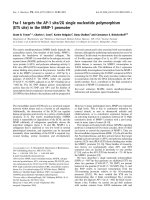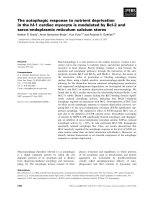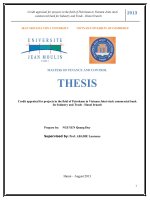Movement in the Field 1 - Worksheet
Bạn đang xem bản rút gọn của tài liệu. Xem và tải ngay bản đầy đủ của tài liệu tại đây (99.9 KB, 11 trang )
Movement in the Field 1: Worksheet
Pre-Listening Activities
1. Match the words on the left with their definitions on the right.
1. Stay alert a) look carefully
2. avoid noise b) very small branches
3. bent c) part of the foot, at the back
4. twigs d) not straight
5. rear end/arse e) to move like a ball on the ground
6. cover f) somewhere to hide behind
7. keep low g) to be safe from falling over
8. observe h) be always looking and listening
9. sole i) to move on your hands and knees
10. to keep your balance j) the part of your body you sit on
11. crawl k) part of the foot; at the bottom and to the front
12. roll l) keep quiet
13. heel m) stay smaller than your real height
2. Discuss in pairs and later with the whole class, how do soldiers move in the field:-
• when there is little danger
• when there is danger and low cover
• when there is danger and very low cover
• to move quickly off the top of a hill
3. In Pairs. Look at the following pictures and describe them to your partner. (
Reproduced from A
SOLDIERS POCKET BOOK ISBN 1-874528-02-0 with the permission of Military Pocket Books Ltd)
Attention! A Military English Course for NCOs
While Listening Activities
1. You are going to hear a description of four different ways of moving in the field during
the day; The Leopard Crawl; The Walk; The Monkey Run and The Roll. As you listen
match each of the pictures above with one of the ways of moving.
2. I. Work in pairs. Partner A has one set of questions. Partner B has another set. Listen to
the description of THE WALK again. Answer your questions.
Questions for Partner A Questions for Partner B
When do you use THE WALK? How should you hold your rifle?
What must you be ready for? How must you behave?
How shouldn’t you walk? What will help you?
ii. Now ask your partner his questions and listen to his answers
3. i. Listen to the description of THE MONKEY RUN AGAIN. Answer your questions.
Questions for Partner A
How do you move when you do the Monkey run?
How can you stop twigs cracking?
What should be careful of when carrying a rifle?
Questions for Partner B
When is using the Monkey Run useful?
What is a possible problem with the Monkey Run?
What should you keep doing?
ii. Now ask your partner his questions and listen to his answers
4. i. Listen to THE LEOPARD CRAWL again. Answer your questions.
Questions for Partner A
When is using The Leopard Crawl useful?
What parts of the body do you use to move?
How do you hold your rifle?
Questions for Partner B
Where should your body be?
What movement helps you to do the Leopard Crawl?
What should you do with your heels, head and body?
ii. Now ask your partner his questions and listen to his answers
5. Listen to THE ROLL again. Partner A describe THE ROLL to Partner B. Partner B,
listen and add any information that A doesn’t give you.
6. Write a description of one of the ways of moving. Read other students’ descriptions.
Attention! A Military English Course for NCOs
Movement in the Field 2: Worksheet
Pre-Listening Activities.
1. Discuss with a partner and then with the whole class. What are the difficulties of
moving at night? What special ways are there of moving at night?
2. In Pairs. Look at the following pictures and describe them to your partner.
Reproduced
from A SOLDIERS POCKET BOOK ISBN 1-874528-02-0 with the permission of Military Pocket
Books Ltd
While Listening Activities
1. You are going to hear a description of three different ways of moving in the field at
night; The Ghost Walk; The Cat Walk and the Kitten Crawl. As you listen, match each of
the pictures above with one of the ways of moving.
2. Listen to the introduction again and complete the following statements.
a) At night you have to be ………………
b) You can’t see where …………………
c) You have to move ……………………
Attention! A Military English Course for NCOs
3. i) The following statements come from The Ghost Walk (GW), The Cat Walk (CW) or
the Kitten Crawl (KC). Listen to the rest of the text and write down which type of
movement each statement refers to. Some have been done already.
a) Search the ground ahead
b) Good for total darkness GW
c) Put your weight down gently
d) Lift your body onto your forearms and toes
e) Crawl on your hands and knees CW
f) Feel the air in front of you
g) Lift your legs high and sweep then slowly outwards
h) Move your knee to where your hand has searched
i) Lie on your front KC
j) Search ahead for twigs
k) Feel gently with your toes for a safe place
l) Press forward and lower yourself onto the ground
3 ii) Work in pairs. Ask and answer questions based on this information.
Example. Q. In what kind of movement do you lie on your front?
A. When you do the Kitten Walk.
4. Listen again and answer the following questions.
a) Why do you lift your legs high and sweep them gently outwards?
b) Why do you put your weight down gently?
c) When your left hand feels in the air, where does it feel?
d) Why do you put your knee where your hand has been?
e) When do you use the Kitten Crawl?
f) What is a big problem with the Kitten Crawl?
Post-Listening Activity.
1. Now write a description of one of the ways of moving at night. Read other students’
descriptions.
Attention! A Military English Course for NCOs
Movement in the Field 1: Answer Key
Pre-Listening Activities
1. Match the words on the left with their definitions on the right.
1. h 2. l 3. d 4. b 5. j 6. f 7. m 8. a 9. k 10. g 11. i 12. e. 13. c
While Listening Activities.
1.
The Roll The Leopard Crawl
The Walk The Monkey Run
2. Partner A
When do you use THE WALK? When you don’t think there’s much danger
What must you be ready for? Instant Action
How shouldn’t you walk? Don’t walk on the flat soles of your shoes
2. Partner B
How should you hold your rifle? It is held in the alert position
How must you behave? You must stay alert at all times
What will help you? It helps if you keep your knees slight bent?









